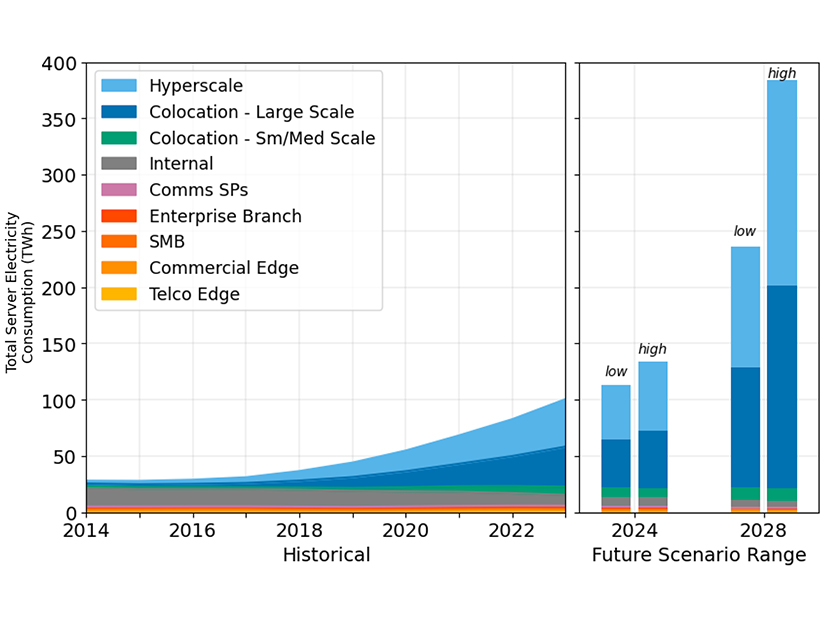
Data centers’ voracious appetite for electricity could spike more than threefold over the next four years, rising from 4.4% of U.S. power demand in 2023 to as high as 12% in 2028, according to a new report from the Lawrence Berkeley National Laboratory.
Energy Secretary Jennifer Granholm said that demand can be met with clean energy. The report “crucially underscores why the Department of Energy has developed and is deploying technologies to enable continued economic growth across American industries,” Granholm said in a press release on the report.
Released Dec. 20, the 2024 United States Data Center Energy Usage Report notes that total energy demand at U.S. data centers doubled between 2017 and 2023, “and continued growth in the use of accelerated servers for AI services could cause further substantial increases by the end of this decade.”
What that means in terms of actual energy use is that data centers gobbled up 76 TWh of electricity in 2018, or 1.9% of total U.S. power demand, rising to 176 TWh in 2023, or 4.4%. Berkeley predicts future growth ranging from 325 to 580 TWh by 2028, or 6.7 to 12% of total U.S. energy demand. The power capacity required to produce that much electricity could run from 74 to 132 GW, the report says.
The report was mandated in the Energy Act of 2020 to update a 2016 data center energy use report, also produced by Berkeley.
The new study uses a “bottom-up” approach to break down data centers’ power demand into individual components. For example, energy use varies across different kinds of servers, ranging from “conventional” single- or dual-process servers to “accelerated AI” servers, which have additional processing units that can “more quickly process large quantities of calculations in parallel.”
Berkeley then drills down into the “wattage levels” of the different types of servers, including nameplate power, power for maximum computational levels and “typical” operational levels, and the “idle” power demand when the server is not being used.
“Operational power in the years 2024 to 2028 is varied between 60 and 80% of the rated [nameplate] power to reflect possible differences in the future,” the report says.
It also tracks energy use by data center type, from the smallest telecommunications servers located in closets to hyperscale centers run by tech giants like Microsoft, Google and Amazon, which have accounted for an increasing percent of demand.
Berkeley also differentiates between the power demand of AI servers used for “training” ― that is, being fed with publicly available data ― and those used for “inferencing,” which is applying those trained models for analysis or predictions. While inferencing accounted for 60% of AI servers’ power use up to 2023, the report anticipates the power demand of training servers will edge them out by 2028, rising to 50 to 53%.
When Demand Doesn’t Show up
The report argues that its bottom-up approach could be more accurate than the projections of growing data center power demand being produced by some U.S. utilities, which typically may be based on market research estimates.
“While not meaningless, historical utility demand forecasts consistently overestimate both peak and average demand,” the report says.
Such overestimates may result from including data centers that have yet to choose an electricity provider, while undervaluing the capacity of renewables, the report says. Some utilities are responding to demand growth with plans to push back previously announced closure dates for coal plants and to front-load construction of new natural gas generation.
Further, according to Berkeley, the information reported by data centers themselves does not provide the level of detail needed for better estimates of power demand.
“Very few companies report actual data center electricity use, and virtually none report it in [the] context of IT characteristics such as compute capacities, average system configurations and workload types,” the report says.
Because such data are often considered proprietary, the report calls for novel approaches to data sharing, such as “developing a repository for companies to provide energy-use data that would be anonymized and aggregated for public release.”
Meeting increased power demand also will require increased collaboration between data centers, utilities, and RTOs and ISOs. The report points to the risk for other customers if a utility builds infrastructure to meet anticipated power demand from a data center that does not show up.
Further research will be needed “to identify key risks for existing customers, data centers and utilities, explore existing contractual arrangements, and propose novel methods for risk-sharing and cost recovery,” the report says.
Another recommendation focuses on “demand bidding,” a demand-side version of RTO/ISO resource adequacy mechanisms. “Large loads would bid their future demand needs, becoming part of a demand-side interconnection queue,” the report says.
In her statement, Granholm noted DOE initiatives, such as its Onsite Energy Program, which offers technical assistance and market analysis to help large energy users deploy clean energy on-site; “so, data centers can be a grid asset rather than a burden,” she said.
But ultimately the report argues for a longer-term, broader approach to data center power demand. The current surge “should be understood in the context of the much larger electricity demand that is expected to occur over the next few decades from … electric vehicle adoption, onshoring of manufacturing, hydrogen utilization and the electrification of industry and buildings.”
“Stakeholders [should] use this relatively near-term electricity demand for data centers as an opportunity to develop the leadership and strategic foundation for an economy-wide expansion of electricity infrastructure.”




